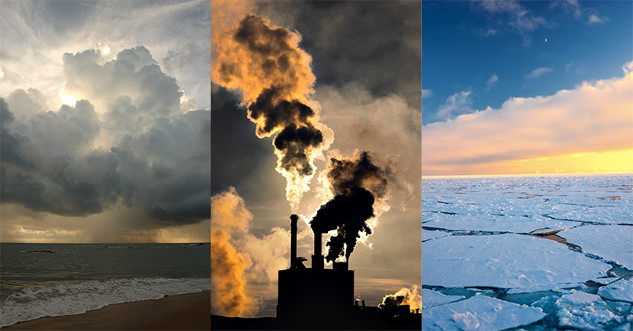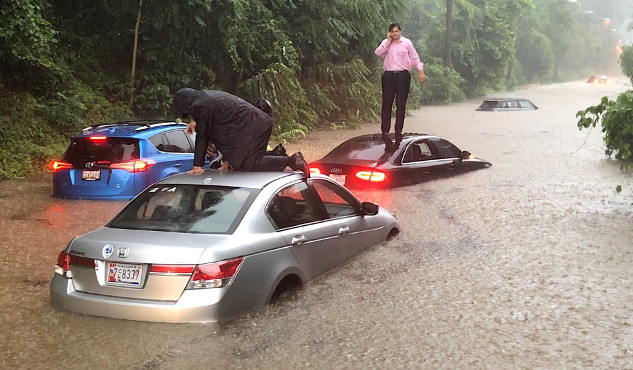
Global warming is a pressing issue that poses severe threats to our planet and all its inhabitants. In recent years, scientists have warned about the potential consequences of reaching a 3°C increase in global temperatures. This accompanying video aims to comprehensively analyze the catastrophic impact of 3°C global warming, including heatwaves, droughts, extreme weather events, rising sea levels, and the urgent need for action to prevent this disastrous future.
Heatwaves and Droughts
Heatwaves and droughts are among the most alarming consequences of 3°C global warming. Heat waves become increasingly prolonged and intense as the Earth's temperature rises, presenting severe risks to human health and well-being. These extended periods of extreme heat can lead to heat-related illnesses, heat strokes, and even fatalities, particularly among vulnerable populations such as the elderly and young children. Moreover, heatwaves also strain ecosystems tremendously, disrupting the delicate balance of biodiversity and threatening the survival of numerous species. The effects ripple through the food chain, impacting wildlife and agricultural productivity.
Global warming also contributes to the escalation of droughts. With higher temperatures, moisture rapidly evaporates from the soil, causing a significant reduction in water availability. This water shortage severely impacts various sectors, including agriculture, as crops require adequate water supply to grow and thrive. In the face of prolonged droughts, agricultural regions experience diminished yields, crop failures, and reduced livestock productivity, jeopardizing food security and increasing the risk of famine. Furthermore, ecological imbalances emerge as droughts disrupt the delicate ecosystems that depend on water sources, leading to the decline of habitats and potential loss of species.

The combined impact of heatwaves and droughts under 3°C global warming is enormous, affecting human societies and the intricate web of life on Earth. The risks to agriculture, biodiversity, and overall well-being are substantial and require urgent attention and action. Efforts to mitigate greenhouse gas emissions, promote sustainable water management practices, and develop climate-resilient strategies are crucial in addressing the challenges posed by these escalating heatwaves and droughts. By prioritizing sustainable practices and making concerted global efforts, we can strive to reduce the devastating effects and create a more resilient future for both human and natural systems.
Extreme Weather Events
The impact of 3°C global warming is evident in extreme weather events' heightened frequency and intensity. Storms, hurricanes, and flooding, already devastating natural phenomena, become even more frequent and destructive under these conditions. The consequences are felt acutely by communities and their infrastructure, leading to widespread devastation and long-term effects.
With rising global temperatures, the atmosphere becomes more energized, creating favorable conditions for the formation of intense storms and hurricanes. These weather events bring about strong winds, heavy rainfall, and storm surges, posing significant threats to coastal and inland regions. These storms' destructive power can severely damage homes, buildings, and critical infrastructure such as roads, bridges, and power systems. The recovery process from such events can take years or even decades, with enormous financial burdens on affected communities and governments.

Flooding brings challenges as rainfall patterns become more erratic and intense, flash floods, and river overflow risk increase. This leads to the inundation of homes, destruction of crops, and contamination of water sources. The aftermath of such floods often involves extensive clean-up efforts and the need to rebuild damaged infrastructure. Additionally, flooding can result in the displacement of populations, leaving individuals without homes and livelihoods and straining resources for emergency response and recovery.
The economic and social costs of extreme weather events are staggering. The loss of lives and the physical destruction of communities are tragic consequences that cannot be underestimated. The displacement of populations, whether temporary or long-term, disrupts social fabric and stability, often leading to long-lasting psychological and emotional impacts. Furthermore, the economic toll is immense, with billions of dollars spent on reconstruction, rehabilitation, and restoring essential services.
Addressing the challenges posed by these extreme weather events requires a comprehensive and multi-faceted approach. Mitigation efforts must focus on reducing greenhouse gas emissions and curbing global warming to limit the severity of these events in the future. Adaptation measures should involve improving infrastructure resilience, implementing early warning systems, and developing strategies to manage water resources effectively. Additionally, communities and governments must work together to enhance disaster preparedness, response, and recovery mechanisms.
By acknowledging the risks and taking proactive measures, we can strive to minimize the impact of extreme weather events in a 3°C warmer world. The urgency to act cannot be understated, as the frequency and severity of these events continue to escalate. Through concerted global efforts, we can build more resilient communities, protect lives and livelihoods, and create a sustainable future better equipped to face the challenges of a changing climate.
Rising Sea Levels
Rising sea levels, a prominent consequence of 3°C global warming, have far-reaching implications for coastal regions worldwide. As temperatures rise and ice sheets melt, the volume of water in the Earth's oceans increases, causing sea levels to rise. This phenomenon poses a grave threat to coastal communities, ecosystems, and infrastructure, exacerbating flooding risks, erosion, and the loss of valuable coastal habitats.
Coastal areas, home to a significant portion of the global population, face the immediate and direct impacts of rising sea levels. Increased flooding becomes a recurrent issue, as even minor storm events can lead to more extensive inundation of coastal zones. This puts communities at risk, with the potential for property damage, displacement of populations, and loss of lives. Furthermore, the encroachment of seawater into freshwater sources can lead to salinization, compromising drinking water supplies and agricultural lands.
Coastal erosion is another consequence of rising sea levels that pose significant challenges. As waves and tidal forces reach further inland, they erode shorelines, gradually removing coastal landforms. This process not only diminishes the natural beauty of coastal areas but also undermines the stability of infrastructure such as roads, buildings, and utilities. Losing coastal land can have severe economic and social implications, especially in areas heavily reliant on tourism, fishing, and other coastal industries.
Rising sea levels threaten coastal ecosystems and habitats. Wetlands, mangroves, and other coastal environments provide critical ecological services, such as protecting against storm surges, filtering pollutants, and serving as nurseries for marine life. However, rising sea levels put these habitats at risk of submergence and degradation. The loss of coastal ecosystems not only disrupts the delicate balance of marine and terrestrial ecosystems but also diminishes the natural defenses against coastal erosion and flooding, further exacerbating the risks faced by human communities.
Addressing the challenges posed by rising sea levels requires a multi-pronged approach that combines mitigation, adaptation, and conservation efforts. Mitigation efforts must focus on reducing greenhouse gas emissions to limit the extent of global warming and slow the rise in sea levels. Adaptation strategies should involve the development of coastal management plans, including implementing nature-based solutions such as the restoration of wetlands and mangroves. Additionally, infrastructure design and land-use planning should account for the projected sea-level rise to minimize risks and ensure the resilience of coastal communities.
By recognizing the gravity of the situation and taking proactive measures, we can mitigate the impacts of rising sea levels and protect vulnerable coastal regions. International collaboration and the engagement of local communities are essential to ensure effective coastal management and sustainable development practices. With a concerted effort, we can safeguard human populations and the fragile ecosystems that depend on healthy coastal environments, fostering a more resilient and sustainable future for future generations.
The Urgent Need for Action
The dire consequences of 3°C global warming make immediate action to mitigate climate change imperative. Governments, organizations, and individuals must work together to reduce greenhouse gas emissions, transition to renewable energy sources, and implement sustainable practices. The need for international cooperation and comprehensive climate policies has never been greater.
The potential impact of 3°C global warming is nothing short of catastrophic. The consequences are dire for humans and the environment, from heatwaves and droughts to extreme weather events and rising sea levels. Urgent action is required to prevent this disastrous future and safeguard the well-being of future generations.
About the Author
 Robert Jennings is co-publisher of InnerSelf.com with his wife Marie T Russell. He attended the University of Florida, Southern Technical Institute, and the University of Central Florida with studies in real estate, urban development, finance, architectural engineering, and elementary education. He was a member of the US Marine Corps and The US Army having commanded a field artillery battery in Germany. He worked in real estate finance, construction and development for 25 years before starting InnerSelf.com in 1996.
Robert Jennings is co-publisher of InnerSelf.com with his wife Marie T Russell. He attended the University of Florida, Southern Technical Institute, and the University of Central Florida with studies in real estate, urban development, finance, architectural engineering, and elementary education. He was a member of the US Marine Corps and The US Army having commanded a field artillery battery in Germany. He worked in real estate finance, construction and development for 25 years before starting InnerSelf.com in 1996.
InnerSelf is dedicated to sharing information that allows people to make educated and insightful choices in their personal life, for the good of the commons, and for the well-being of the planet. InnerSelf Magazine is in its 30+year of publication in either print (1984-1995) or online as InnerSelf.com. Please support our work.
Creative Commons 4.0
This article is licensed under a Creative Commons Attribution-Share Alike 4.0 License. Attribute the author Robert Jennings, InnerSelf.com. Link back to the article This article originally appeared on InnerSelf.com

Related Books:
The Future We Choose: Surviving the Climate Crisis
by Christiana Figueres and Tom Rivett-Carnac
The authors, who played key roles in the Paris Agreement on climate change, offer insights and strategies for addressing the climate crisis, including individual and collective action.
Click for more info or to order
The Uninhabitable Earth: Life After Warming
by David Wallace-Wells
This book explores the potential consequences of unchecked climate change, including mass extinction, food and water scarcity, and political instability.
Click for more info or to order
The Ministry for the Future: A Novel
by Kim Stanley Robinson
This novel imagines a near-future world grappling with the impacts of climate change and offers a vision for how society might transform to address the crisis.
Click for more info or to order
Under a White Sky: The Nature of the Future
by Elizabeth Kolbert
The author explores the human impact on the natural world, including climate change, and the potential for technological solutions to address environmental challenges.
Click for more info or to order
Drawdown: The Most Comprehensive Plan Ever Proposed to Reverse Global Warming
edited by Paul Hawken
This book presents a comprehensive plan for addressing climate change, including solutions from a range of sectors such as energy, agriculture, and transportation.
Click for more info or to order


























